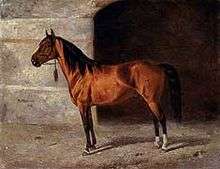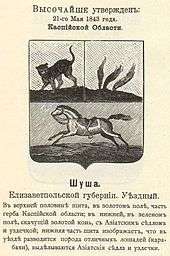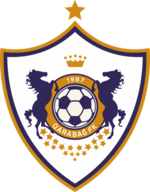Karabakh horse
The Karabakh horse (Azerbaijani: Qarabağ atı), also known as the Karabai[2] or Karabakhskaya in Russian, is a mountain-steppe racing and riding horse. It is named after the geographic region where the horse was originally developed: Karabakh in the southern Caucasus, an area which is part of Azerbaijan. The breed is noted for its good temperament and speed; in 2004, a Karabakh horse named Kishmish from the Agdam stud in Azerbaijan covered 1,000 metres in one minute, nine seconds and 1,600 metres in one minute, 52 seconds.[3]
 Alyetmez, from the stud of Khurshidbanu Natavan-Utsmiyeva, at the second All-Russian Exhibition in 1867 | |
| Country of origin | Karabakh region |
|---|---|
| Traits | |
| Height | |
The Karabakh is thought to be influenced by Persian horses and the Akhal-Teke, Kabarda, Turkoman and Arabian breeds, and it influenced the development of the Russian Don during the 19th century.[4] It is bred primarily in Azerbaijan's Shaki region. The breed numbers below 1,000, and it is threatened with extinction.[5]
Characteristics
The Karabakh is hardy, strong, tough and sure-footed, standing 14.1–15.2 hands (57–62 inches, 145–157 cm) high.[6][1][2] It has a small, well-defined head, a straight profile with a broad forehead, and large nostrils. The neck is set high, average in length, muscular and elegant. It has a compact body, with well-defined and well-developed muscles. The shoulder is often upright. The horse has a deep chest, a sloping croup and long, fine, strong legs with small joints. Its chest is narrow and it is not very deep through the girth, due to the Akhal-Teke influence.[7]
The skin is thin and soft, with a shiny coat. The main colors are chestnut and bay, with a characteristic golden tint; some are gray, and palominos and buckskins are rare. White markings are permitted.[8] As well as being fast and agile, the Karabakh is known for its endurance and loyalty.[9]
History

The Karabakh has close links to the Akhal-Teke (which is bred in Turkmenistan) and the Turkoman horse, which is bred in Iran. Some historians believe that they were originally a single breed and significantly influenced the development of the Arabian horse. These facts were found out after numerous researches in XIXth century.
The Karabakh region was known for the quality of its horses; the classical historian Strabo describes its province of "Orchistene" as supplying the kingdom with the "most cavalry."[10] According to some sources, tens of thousands of horses with golden-chestnut coloring (characteristic of Karabakhs) were seized by the Arabs during their eighth- and ninth-century conquest of Arran.[11]
The breed acquired its present characteristics during the 18th and 19th centuries. In Transcaucasia, Karabakh Khanate was known as a place for breeding of horses. Factory of the khanate was the main farm of purebred horses, which were not held for sale, but were only presented as gifts.[12] According to Diterikhs, in 1797, right after the death of Agha Mohammad , Ibragim khan got his stable. [13]There is some evidence that Ibrahim-Khalil (1763-1806), ruler of the Karabakh Khanate, had a herd numbering 3,000-4,000 (primarily Karabakhs). During the 19th century, Karabakhs became popular in Europe.[14] An English company purchased 60 Karabakh mares from Mehdi-Kulu Khan, the last ruler of the Karabakh Khanate, at a large 1823 sale. Although its numbers were impacted in 1826 during the Russo-Iranian war, the breed remained intact.

The Karabakh played a significant role in the formation of the Russian Don breed. The heir of Russian general Valerian Madatov sold all his horses, including 200 Karabakh mares, to a breeder in the Don region in 1836. The mares were used to improve the Russian Don into the 20th century.
Karabakh numbers sharply decreased again during the early 20th century, primarily because of civil and ethnic wars in the Caucasus in general and the Karabakh region in particular. The breeding enterprise established by the Karabakh khans and developed by their heirs was destroyed in 1905. Karabakhs were bred to other breeds, resulting in changes including a reduction in size.[15]

In 1949, the breed was revived at the Agdam stud in Azerbaijan. Seven years later, the Karabakh stallion Zaman and an Akhal-Teke named Mele-Kush were presented to Queen Elizabeth II by the Soviet government.
The breed experienced another setback during the Nagorno-Karabakh War. Before the 1993 capture of Agdam by Armenian forces, most of the Karabakh horses were moved from the Agdam stud.[16] They are currently bred in winter pastures on the lowland Karabakh plains between Barda and Agjabadi.[17]
During the years of Russian Empire
In 1805 Karabakh became part of Russia. Mehdigulu Khan, who ruled after Ibragim Khan, was not interested in the development of stud farms. As a consequence the quantity of khan horses was decreasing. In 1822, Mehdigulu Khan ran away to Persia, and his best horses were presented as gifts to his close people. Unlike Mehdigulu Khan, his daughter Khurshidbanu Natavan was actively engaged in the development of stud farms. Natavan's Karabakh horses took part in the Exposition Universelle (1867), agricultural exhibition in Moscow (1869), in Tbilisi (1882) and were awarded golden medals and certificates of honour. Karabakh horses were also awarded at the Second All-Russian Exhibition in 1869: Meymun - silver medal, Tokmak - bronze medal. At the Exposition Universelle (1867) in Paris, Khan got a silver medal. [18]
According to modern Azerbaijani sources, not only Khan's daughter, but also many Karabakh bays owned stud farms. Among them were Ugurlu Bay, Jafargulu Khan, Rustam Bay Behbudov, Kerim-aga Javanshir, Shamil bay and others. Overall in the middle of the XIXth century, there were 11 stud farms, with 250 stallions and 1450 fillies. [19]
Karabakh horses were used by Russian officers who served in the Caucasus. Russian poet Aleksandr Pushkin, who traveled to Arzurum in 1829, wrote in his travel notes that young Russian officers were riding Azerbaijani horses.[20] On 21 May 1843, the coat of arms of Shusha was approved and Karabkh horse was depicted on it.
During the years of Azerbaijan Republic
Currently Karabakh horses are breed at two stud farms: in the village of Lambaran of Barda region and in Agstafa. Private stud farms exist in line with state enterprises. Because of Karabakh war, the number of horses significantly decreased. This happened because horses were often moved from one place to another and pregnant fillies experienced misbirths. Moreover, horses were breed in unsatisfactory conditions. [21]
During the last years, Ministry of Agriculture of Azerbaijan pays special attention to the development of horse breeding. Export of Karabakh horses is forbidden. According to Xandan Rajabli, the director of association Azbreeding, there areapproximately 20 stud farms in Azerbaijan, that take care of 200 thoroughbred Karabkh horses.
In 2013, Chovqan, a traditional Karabkh horse riding game in the Republic of Azerbaijan was mentioned in the UNESCO Intangible Cultural Heritage Lists.
On 13 February 2017, Organisational Committee of Islamic Solidarity Games introduced mascots: Karabakh horses Inca, that represented beauty and tenderness and Casur, that stood out with self-confidence and love of freedom. [22]
In popular culture

The Karabakh horse is the national animal of Azerbaijan and the official symbol of the Agdam and Shaki districts. The horse, of great cultural importance to the people of Azerbaijan, appears in literature and on postage stamps.[23][24][25] Qarabağ FK's logo contains two rearing horses.
According to Kurban Said's novel Ali and Nino, "I looked at the horse and was struck numb. There stood the red-golden miracle of Karabakh ... one of the twelve golden horses in the whole world ..."[26] A horse in Karabakh is described in Mikhail Lermontov's poem, "Demon".[27]
In 2012, the breed appeared at the Royal Windsor Horse Show to perform at the Diamond Jubilee of Elizabeth II.[28]A monument to the Karabakh horse was unveiled in Belgium in March 2017,[29] and the Karabakh was the mascot of the 2017 Islamic Solidarity Games.[30]
See also
References
- Reddick, Kate (1976). Horses. New York: Bantam Books. p. 72. LCCN 75-21601.
- Nissen, Jasper (1963). The Young Specialist Looks at Horses. London: Burke Publishing Company. p. 73.
- Qarabağ atları da əldən gedir... (in Azerbaijani)
- Zoo encyclopedia:Карабахская лошадь(in Russian)
- Карабахская порода лошадей Archived 2009-04-10 at the Wayback Machine(in Russian)
- Карабахская лошадь — article from Great Soviet Encyclopedia (in Russian)
- Qarabağ atları da əldən gedir... (in Azerbaijani)
- Карабахские лошади: К истории породы (in Russian)
- "Karabakh horses on Gunay Equestrian". Archived from the original on 2009-12-15. Retrieved 2009-12-13.
- Strabo. Geography. 11.14.4.
- İndi onlar elə məcburi köçkünlərin özləri kimi sıxıntı içindədilər Archived 2015-05-18 at the Wayback Machine(in Azerbaijani)
- "С. М. БРОНЕВСКИЙ->ИСТОРИЧЕСКИЯ ВЫПИСКИ->ЕПОХА III Ч. 2". www.vostlit.info. Retrieved 2018-01-27.
- horseworld. Карабахские лошади - Представляем породу. Конный мир (in Russian). Retrieved 2018-01-27.
- musavat.com (in Azerbaijani)
- Karabakh Horses
- Карабахские скакуны (in Russian)
- At muraddır, insanların dostudur Archived 2010-12-30 at the Wayback Machine(in Azerbaijani)
- horseworld. Карабахские лошади - Представляем породу. Конный мир (in Russian). Retrieved 2018-01-27.
- Шушинский, Фирудин (1968). Шуша. Баку: Азербайджанское Государственное Издательство.
- Пушкин, Александр Сергеевич. А.С. Пушкин. Путешествие в Арзрум. rvb.ru (in Russian). Retrieved 2018-01-27.
- Wither, Emily. "Azerbaijan fights to protect horse from extinction". CNN. Retrieved 2018-01-27.
- 1news. "Объявлены Маскоты Игр Исламской Солидарности Баку 2017". Retrieved 2018-01-27.
- Wither, Emily. "Azerbaijan fights to protect national animal from extinction". CNN. Retrieved 16 November 2011.
- www.agro.gov.az "Azərbaycanın ən qədim dağ minik at cinsidir" (in Azerbaijani)
- Macguire, Eoghan. "Country Profile: Azerbaijan". cnn.com. CNN. Retrieved 13 November 2011.
- "The Karabakh Horse Resurgent". Visions. March 2012. Retrieved July 12, 2016.
- ""IN KARABAKH A FIERY CHESTNUT BRED"". Region Plus. Retrieved 9 April 2017.
- "Karabakh Horses Gallery". www.ponymag.com. Retrieved 12 August 2014.
- "Karabakh horse monument unveiled in Belgium". 27 March 2017. Retrieved 22 April 2017.
- "Mascots of 4th Islamic Solidarity Games Baku-2017 revealed [PHOTO]". AzerNews.az. 13 February 2017. Retrieved 9 April 2017.